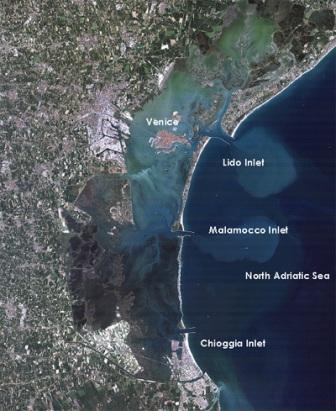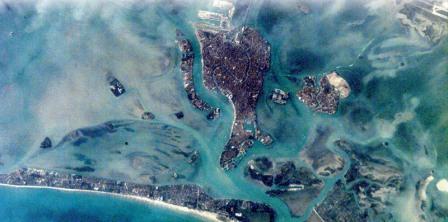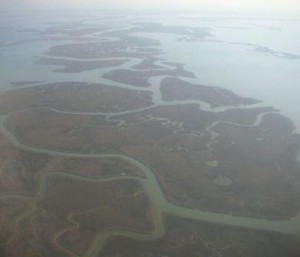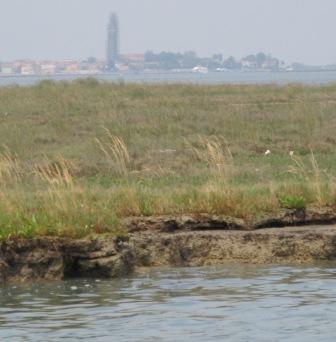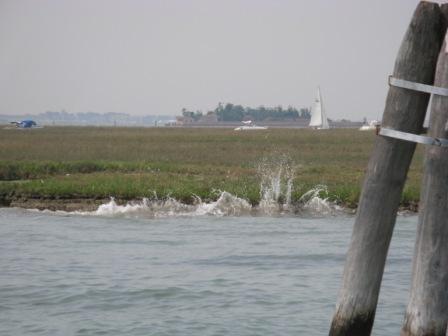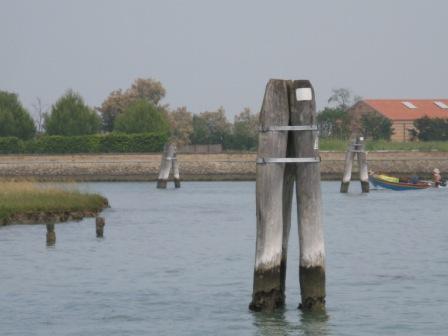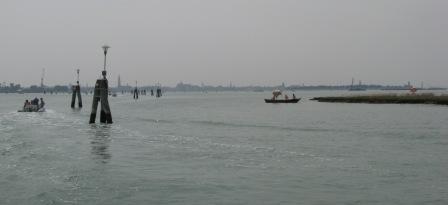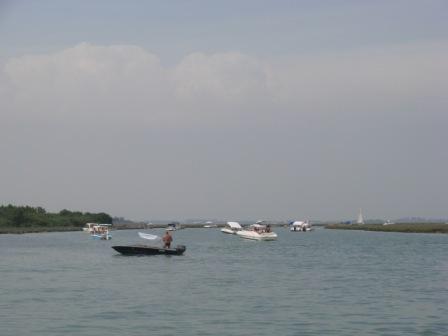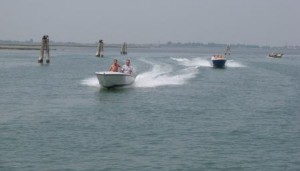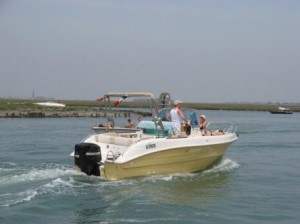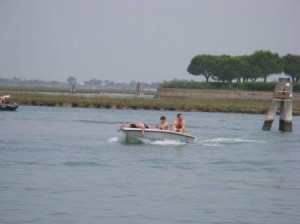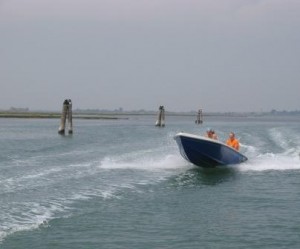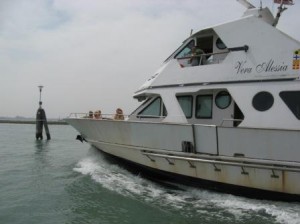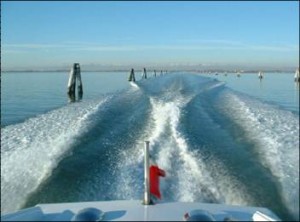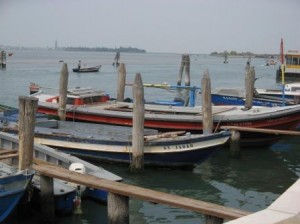Now that I have pounded the subject of acqua alta into unconsciousness, you may be wondering if there are any solutions. It’s not unreasonable, I guess, to want to suppose that there could be some action(s) that would limit or even prevent water from inconveniently covering your street, even for only two hours.
Certainly many of the articles which continue to appear, year after year — there must be a workshop in a cave where some crazed Geppetto keeps producing stories on how Venice is being engulfed — tend to make it sound as if Venice’s health and future happiness depends almost exclusively on keeping the water out.

So let me urge you, before we continue, to disregard, as far as you can, the drizzle of extravagant statements drenching almost every article about this project. Such as comments by journalists in love with their clever way with words (“…soaked Bruno Maglis have become more the rule than the exception…” You’ve got money for Maglis — or for any kind of shoes — but you haven’t figured out that you can take them off to keep them dry? Wow… And by the way, it isn’t true), or this, by an Italian professor of physical oceanography at MIT: (“”The gates are really the only solution.” Really? The only?), or the claim that high water really, really distresses the old people. All the old people I’ve ever talked to are the ones who make the least fuss about it of anybody.
The good news: There is no lack of useful and feasible ideas on how to limit or prevent high water in the city. In fact, we have been inundated by a plethora of proposals, many of them simple, easy, not damaging to the environment and cheap.
The bad news: Only one solution has been chosen, and it is none of the above. Sometimes referred to as the “floodgate project,” this savior is called MOSE. It is the biggest, most expensive, most drastic, most irreversible, heaviest-impact-on-the-lagoon-as-a-whole solution that anyone could have imagined. I say that because if there were a solution that could have been more drastic and more expensive, they would have picked that one instead.
What is it?
MOSE stands for Modulo Sperimentale Elettromeccanico, or Experimental Electromechanical Module. It consists of a sequence of a total of 79 steel caissons — boxes, really — lying on the lagoon floor, which can be raised to form a wall which will block an exceptional incoming tide.
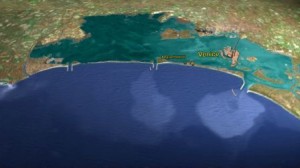
The Venetian lagoon is enclosed by a long strip of barrier islands which block the Adriatic Sea except at three inlets (called “bocche,” or “mouths”) through which the tide passes every six hours, coming in or going out. This exchange of water is crucial to the lagoon’s ecosystem.
How does it work?
Each of the three “mouths” of the lagoon has been dug to accommodate a concrete frame installed on the bottom and sides of the channel. Attached to this frame, by means of hinges, are the aforementioned 79 metal boxes which normally will lie on the channel bottom, filled with water.

If an exceptional high tide is expected (or more than 110 cm [3 1/2 feet]) above median sea level, the water will be pumped out of the boxes and compressed air pumped in which will cause them to rise up and form a wall preventing the water from entering the lagoon. When the tide subsides, these caissons will be filled with water again and they will return to their dormant state on the inlet floor.
When will it be used?
The job of this colossal construction is to prevent — not just any high tide, but an exceptional one — from reaching the city. The frequency of a tide of this magnitude is predicted by the city as being four times a year.
Therefore, any high water up to 110 cm is going to come ashore just as it always has, and we will continue to break out the boots and merchants in low-lying parts of the city will continue to stow their merchandise and keep their squeegees at hand to sweep the receding water out the door. Their keening laments will also be primed and ready to go.
Who thought this up?
As with many large public works, it is the love child of politicians, engineers and builders. In this case, an assortment grouped together as the Consorzio Venezia Nuova (New Venice Consortium). These are not lagoon-huggers. Many of its members are in business, often doing the sort of work that MOSE requires.
1973: The Special Law for Venice is passed, which declares the city’s welfare to be of “preeminent national interest.”
1975: The Ministry of Public Works announces an international competition for project designs which would limit high water. Five projects are accepted for evaluation.
I will leap ahead here and spare you the year-by-year chronicle of yes/no, he said/she said, did so/did not, claims and counterclaims. It’s like Jarndyce and Jarndyce. A full account of this 30-year struggle would be a ponderous assortment of lists of names and companies and government agencies and ministers, environmental organizations, suits and countersuits at every level, from Venice itself to the European Court of Justice in Luxembourg. By now, the only people in the world who have not been involved in this in some way are you and me.
By now, 63 percent of the work is finished. But the controversy is still very much alive.
Next: Why everybody isn’t excited about it

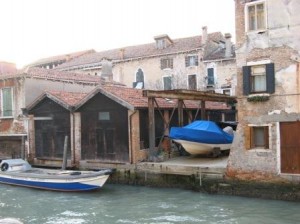
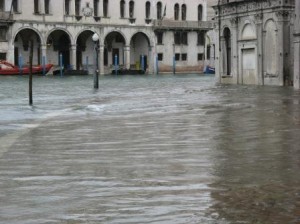
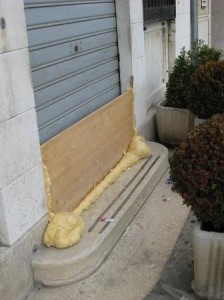
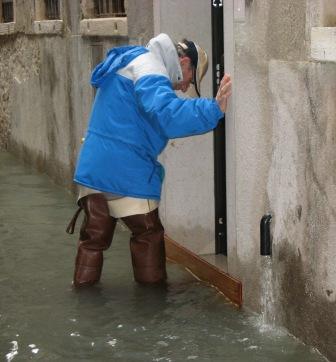

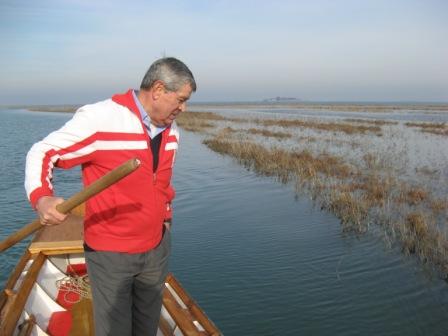
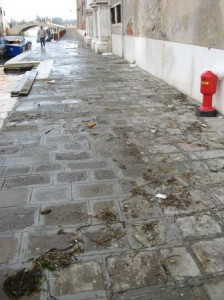
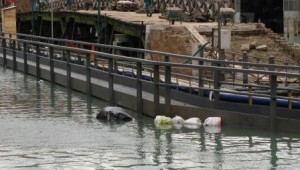
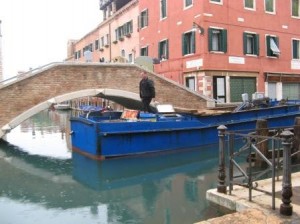 not only for taxis and barges but also some vaporettos and/or motoscafos. They have to change their normal routes because the high water prevents them from passing under certain bridges. There are alternatives by which they resolve this temporary dilemma, but it adds inconvenience to your own trajectory. As for heavy work boats and taxis, they either have to pick another route from A to B, or wait for the tide to turn. Tiresome, true, but hardly the stuff of calamity.
not only for taxis and barges but also some vaporettos and/or motoscafos. They have to change their normal routes because the high water prevents them from passing under certain bridges. There are alternatives by which they resolve this temporary dilemma, but it adds inconvenience to your own trajectory. As for heavy work boats and taxis, they either have to pick another route from A to B, or wait for the tide to turn. Tiresome, true, but hardly the stuff of calamity.
